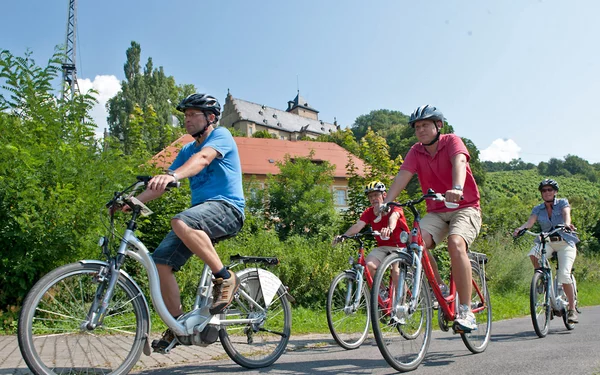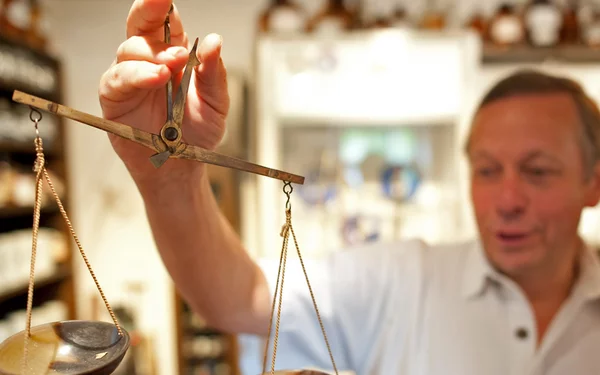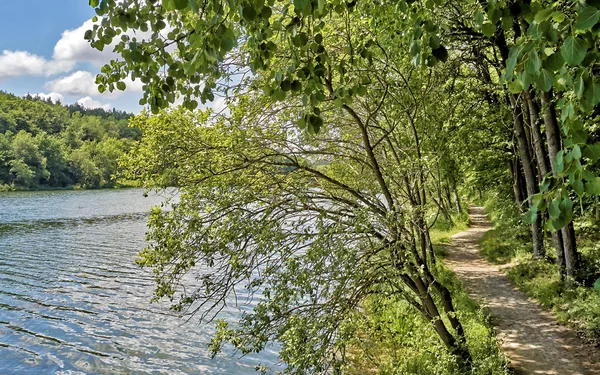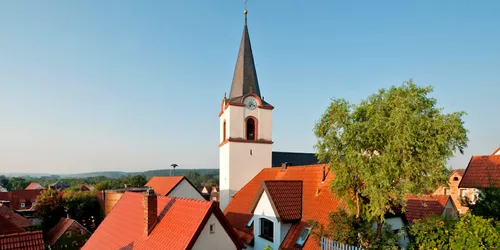Experience the Schweinfurt Oberland
Healing plants, steadfast priests and resourceful industrialists. On this cycle tour, you will find out what the imposing Mainberg Castle has to do with the famous gentleman playboy Gunter Sachs.
Schweinfurt
6 h
56 km
A challenging 570 metres in altitude are mastered on this e-bike tour. Rustic, wooded sections alternate with gently undulating field and meadow landscapes.
Along the way, you will learn about healing plants, hard-working monks, steadfast priests and resourceful industrialists. Finally, you will find out what the imposing Mainberg Castle has to do with the famous gentleman playboy Gunter Sachs.
A cycle tour for nature lovers, culture vultures and explorers
Arrive relaxed and hire bikes from local hire companies. The capacity for taking bikes on trains is limited and, depending on capacity utilisation, it is not possible to guarantee that you will be able to take your own bike with you.
Start and end station
Bahnhof Schweinfurt-Mitte
56 km / 6 Stunden
Bahnhof Schweinfurt-Mitte
Our tip: Please make sure to check your train connection and the expected capacity before you start your journey.
Schedule
Tour starts on Bahnhof Schweinfurt-Mitte
Direction
Bicycle service Schweinfurt-Mitte station
There are 25 bicycle parking spaces in the immediate vicinity of the railway station.
Gutermann-Promenade
97421
Schweinfurt
Direction
The Schweinfurt 360° tourist information centre is less than a kilometre from Schweinfurt-Mitte station.
E-bikes can be hired here for the tour. Remember to book in good time!
Tourist Information Schweinfurt 360°
A total of 4 e-bikes from the regional manufacturer Winora can be hired from the Schweinfurt 360° Tourist Information Centre outside opening hours from April to the end of October.
They can be hired for one or more days. The team at the Tourist Information Centre can arrange for you to collect and return them individually and flexibly outside our opening hours by telephone. Alternatively, bikes can be returned to bike boxes near the Museum Georg Schäfer and the Main cycle path. Bikes are only available for hire from April to October.
Markt 1
97421
Schweinfurt
Direction
On the saddle and off you go. Initially, the route runs for around 6 kilometres along the beautiful River Main.
The entrance to the Apothekergarten is via Ludwig-Grobe-Straße.
Apothecary garden
Nature used to be our pharmacy. Wild medicinal plants were everywhere, and the rural population diligently collected them and used them to make teas and other tried and tested household remedies. In the apothecary garden in Schonungen, 140 indigenous medicinal plants can be found in four areas. Some of them are threatened with extinction or have already disappeared completely from our landscape. However, almost all of them are still in use today. Pharmaceutical companies conduct research on the plants and produce drops, ointments or tablets from their active ingredients.
The medicinal plant garden is organised according to various ailments: Which plants help with problems with digestion, circulation, wound treatment or when something is bothering us? What can we do for coughs or when the liver and gall bladder need support? Overview boards make a visit to the pharmacy garden exciting and informative. But it is also simply beautiful and pleasant to stroll between the themed beds and the shrubs and perennials or to savour the aromatic air on a bench in the scented garden.
The Apothecary Garden is open all year round during the day. It is self-explanatory thanks to the excellently signposted circular route. It is also worth combining a guided tour with a visit to the pharmacy museum in Mainberg.
Ludwig-Grobe-Straße
97453
Schonungen
Direction
Towards the end, your tour will also take you past the Small Pharmacy Museum in Mainberg.
Now it really gets going! The cycle path leads through Schonungen into the hilly forest areas towards the Haßberge mountains. On the first stage, it winds along the course of the Steinach river to Marktsteinach. Many former mills can be seen along the way.
The route continues via Abersfeld and through the Löffelsterz golf course, then on quiet and wooded cycle paths via Reichmannshausen to Ellertshäuser See.
Lake Ellertshausen
Lake Ellertshäuser, around 20 kilometres north of Schweinfurt, is the only reservoir and, at 33 hectares, the largest reservoir in Lower Franconia. Originally created as a water reservoir for irrigating the fields in this part of the Franconian dry plateau, today it is primarily a nature and leisure paradise.
Idyllically surrounded by forest, the lake warms up to 22° Celsius in summer. Then there is sport and fun around the not too cool water: a large sunbathing lawn with a neighbouring beach volleyball court in competition dimensions, a sandy beach with a water adventure playground for children of all ages, a swimming island and platforms for jumping and diving into the water.
If you like, you can go pedal boating, surfing, paddling or diving and then treat yourself to a cool drink and delicious food at the restaurant or kiosk with a view of the lake. Lake Ellertshausen is not only worth a visit in summer. It can be hiked around barrier-free at any time of year, and the nature discovery trail on the northern shore provides information about the local flora and fauna.
Direction
Where Lake Ellertshausen is today, there used to be a settlement.
As early as 1480, however, the former Ellertshausen was labelled a deserted area and was therefore abandoned. It was probably the monks from the Neustadt am Main monastery who reclaimed the area a thousand years ago. They already had a settlement in nearby Altenmünster. That's where we're going now.
Just drive two kilometres north along the edge of the forest.
Catholic parish church of the Assumption of the Virgin Mary
The core of the choir tower of the parish church dates back to the 13th century. The parish is even older, having existed since the 9th century. The roots of the village of Altenmünster itself go back two hundred years further. However, it is not only old, but also, as the name suggests, a cathedral. This means that it goes back to monks who settled here and promoted settlement by clearing and reclaiming the land.
From 1626, Liborius Wagner, who was beatified as a martyr in the 20th century, was parish priest in Altenmünster. Because he refused to renounce the Catholic faith, he was taken to the nearby Meinberg Castle in 1631, where he died after suffering the worst tortures.
At this time, the parish church of the Assumption of the Virgin Mary already had a cross vault, a baptismal font, a sacrament house and a small bell in the tower, but was in poor condition. The nave was built in 1672. Over time, the tower was given a pointed roof in the style of the Würzburg prince-bishop and great builder Julius Echter.
Next to the free-standing parish church is one of the most beautiful historic vicarages in Franconia, where Blessed Liborius Wagner once lived. It used to be part of the parish priest's job to manage the parish estate himself.
Every year on the Saturday after Ascension Day, the faithful and even bishops from the diocese make a pilgrimage to Altenmünster on a pilgrimage.
Am Dorfbrunnen 4
97488
Stadtlauringen
Direction
Now you can really get pedalling again. The tour leads via Ebenhausen and Hoppachshof, along Weipoltshauser Grund and back south via Üchtelhausen.
On the last section, you will come across the "Dianenlust", a hunting lodge built in 1824 in the middle of forests that are sustainably managed by the Bavarian State Forests. From here it's downhill to Mainberg. On the opposite slope, you will discover the castle of the same name.
Mainberg Castle
The history of Mainberg Castle began with a truss tower, which was built in the 10th century and still stands today. When it was first mentioned in a document in 1245, the castle was still called Mainberg Castle and belonged to a count. Duchess Margarethe von Braunschweig-Wolfenbüttel gave it its present form in the 15th century.
Partially destroyed during the Peasants' War, the property passed from the counts to the Bishop of Würzburg in 1542. After secularisation, when ecclesiastical estates in Bavaria were expropriated in the early years of the 19th century, the castle changed hands several times.
The count's and ecclesiastical lords were followed mainly by industrialists. It all began in 1822 with Wilhelm Sattler, a pioneer of the early industrial era in Bavaria. At the end of the 1820s, Sattler employed 450 workers, more than a sixth of the industrial labour force in Lower Franconia. Among other things, he owned factories for starch and sugar.
His wallpaper factory at Mainberg Castle was not the only production facility within historic walls; he also ran an earthenware factory at Aschach Castle. He became known worldwide for his "Schweinfurt Green", a colour with a greater luminosity than anything previously known. Unfortunately, it is not only beautiful, but also poisonous.
In 1915, Ernst Sachs bought the castle and manufactured ball bearings. His invention can still be found on modern bicycles today: the torpedo freewheel hub. One of the richest married couples in Germany had a son at Mainberg Castle in 1932: Gunter Sachs. He became a jetsetter and playboy in the 1960s and was the husband of French film icon Brigitte Bardot for a few years.
Difficult years began for the castle when it was sold to the dubious hair tonic manufacturer Wilhelm Heger. The new owner was convicted of fraud and the castle was auctioned off by the state. The city of Schweinfurt bought it at auction, albeit without a utilisation concept, and sold it to a building contractor twenty years later. He ensured the preservation of the castle, which was in need of renovation, and repaired it at great expense. However, he died at Mainberg Castle at the age of 52 without any descendants.
Today, the castle is closed to the public, a preservation organisation has been founded and since 2017, the castle's existence has been under threat.
Ernst-Sachs-Straße 6
97453
Schonungen
Tour ends on Bahnhof Schweinfurt-Mitte
Direction
The success of the important castle owner Wilhelm Sattler would not have been possible without his partner, the pharmacist Friedrich Wilhelm Ruß, with whom he researched industrial production methods for food and colours.
If you have booked a visit to the pharmacist's museum dedicated to him (Sotierstraße 2, 97453 Schonungen, Tel. 09721 75810), take a short detour there now before heading back to the railway station.
You then cycle back along the Main to Schweinfurt-Mitte station. Don't forget to return your bike to the tourist information centre.


















